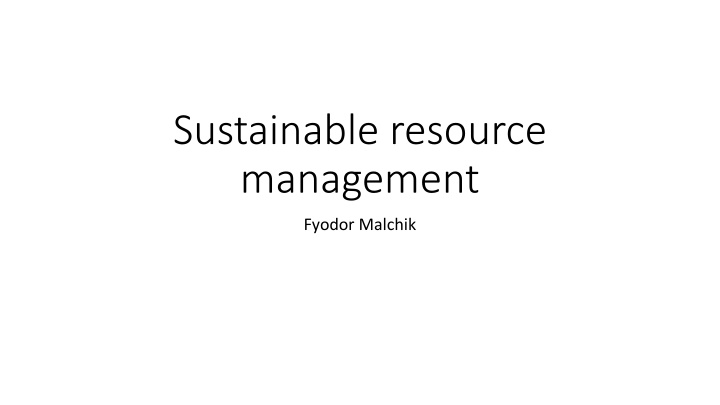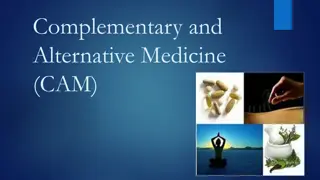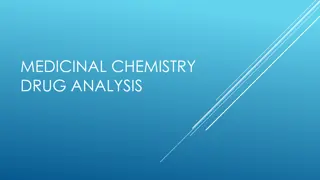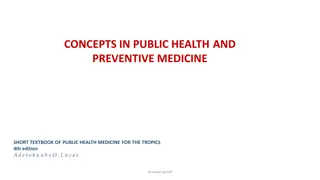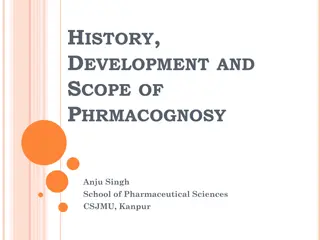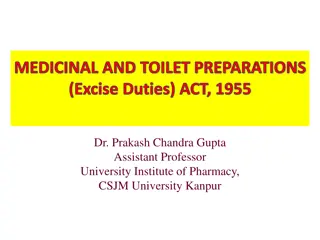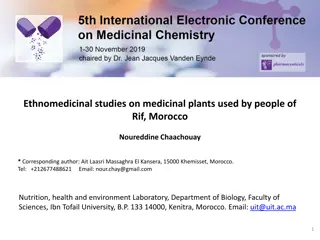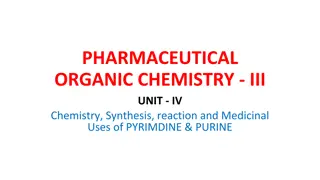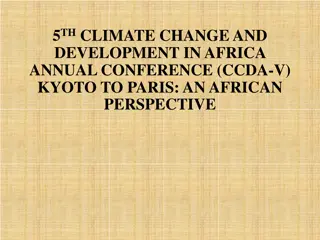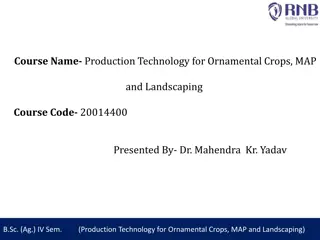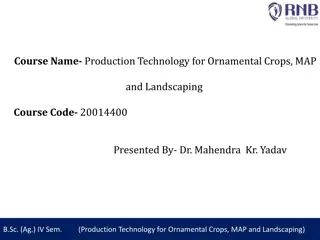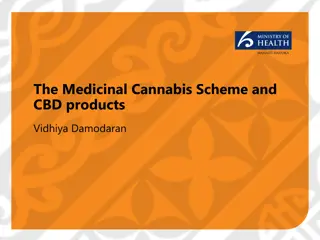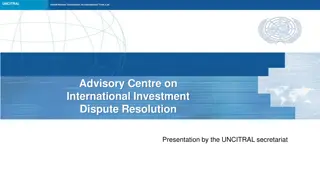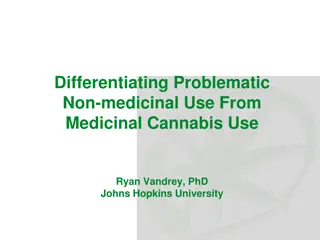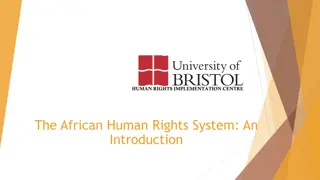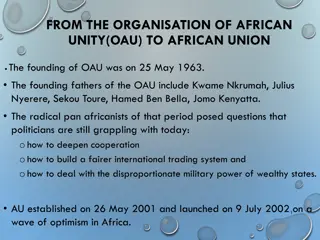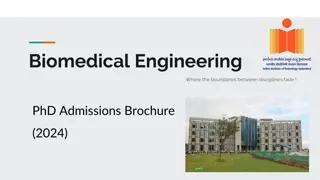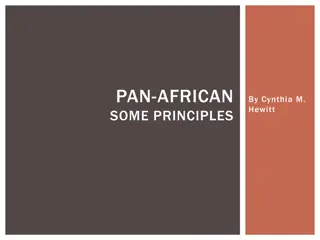African Centre for Excellence in Phyto-medicine Research: Addressing Medicinal Plant Utilization
The African Centre for Excellence in Phyto-medicine Research and Development is pioneering the integration of traditional plant-derived medicines into modern healthcare. This project, funded by the European Union's Horizon 2020 program, aims to establish an Open Access Repository (OAR) for plant-based medical research. Explore the project's scientific problem, architecture, objectives, achievements, and encountered problems towards enhancing medicinal plant utilization in healthcare.
Download Presentation

Please find below an Image/Link to download the presentation.
The content on the website is provided AS IS for your information and personal use only. It may not be sold, licensed, or shared on other websites without obtaining consent from the author.If you encounter any issues during the download, it is possible that the publisher has removed the file from their server.
You are allowed to download the files provided on this website for personal or commercial use, subject to the condition that they are used lawfully. All files are the property of their respective owners.
The content on the website is provided AS IS for your information and personal use only. It may not be sold, licensed, or shared on other websites without obtaining consent from the author.
E N D
Presentation Transcript
Sustainable resource management Fyodor Malchik
Target 9, Goal 7 of the Millennium Development Goals Ensure Environmental Sustainability Integrate the principles of sustainable development into country policies and programs and reverse the loss of environmental resources. The indicators linked to this target refer to: Forest cover and biodiversity Sustainable energy Water
WSSD Plan of Implementation Managing natural resources in an integrated Manner is essential for sustainable development In Johannesburg, international consensus was reached around the two basic approaches that should organize the global effort towards environmentally sustainable development: Integrated management of natural resources, including energy; Enhancement of cooperation and synergies, with emphasis on the regional level.
A compelling rationale for the need of a GEF response to the call for integration: The clear and coherent message deriving from MDGs and WSSD The GEF Operational Strategy that recognizes the need for integrating water, land use and biodiversity, and adopts the ecosystem approach The size of the GEF portfolio - risks of overlaps and antagonistic linkages in many geographic areas The addition of the Land Degradation focal area The new focus on climate change adaptation The recommendations of STAP on interlinkages and groundwater
An enabling environment for stress reduction On the ground integration can be experimented more effectively when the stage of the implementation of stress reduction/mitigation measures has been reached, and the enabling environment is in place. These four pre-requisites may provide the criteria for identifying and selecting the opportunities for integration where action can be taken in the short term.
Breaking focal area barriers: Possible actions Merging of resources Increase in PDF-B funds for the design of integrated projects and multi-project programs Incentives (fee premiums?) to encourage our agencies to engage in integrated programs Adoption of a new set of overall GEF strategic priorities , which would privilege integration Creation of new multi-focal operational programs (Integrated Natural Resources Management in Hydrographic Basins, or Energy for Environmentally Sustainable Development in LDCs and SIDS) systematic dialogue among focal areas in the Secretariat and Task Forces and strengthening of Task Forces
The new challenge in the IW focal area: Catalyzing an Integrated Response to Strategic Action Programs LAND WATER BIODIVERSITY CLIMATE CONTAMINANTS
EXAMPLE OF A POSSIBLE INTEGRATED APPROACH THE CASPIAN SEA BASIN The Challenge: Sustainable Integrated Management of the Caspian Environment
Kazakhstan Russian Federation Azerbaijan Turkmenistan Iran
As a result of a first IW - GEF project, the riparian countries have agreed on a Strategic Action Programme and on a binding environmental Caspian Convention Payvand's Iran News ... 11/5/03 Convention for Protection of Caspian Environment signed in Iran The Convention for the Protection of the Marine Environment of the Caspian Sea (Tehran Convention) was signed by the plenipotentiary representatives of the five littoral countries of the sea in Tehran on Tuesday, IRNA reported. Iran, Russia, Kazakhstan, Azerbaijan and Turkmenistan are the five countries situated around the world's biggest lake. According to the Tehran Convention, all Caspian Sea littoral countries are committed to take all necessary measures, individually or collectively, to reduce and control pollution of the sea.
Transboundary Diagnostic Analysis A science based TDA has guided in defining targets, strategies, priorities Strategic Action Programme The SAP for the Caspian Basin has been adopted by the littoral countries. It is a commitment to action. National Caspian Action Plans Actions identified in the SAP are being translated into national commitments
Priority regional environmental concerns identified by the TDA and addressed by the SAP: Over-exploitation of bio-resources Threats to biodiversity Water pollution Unsustainable coastal area development
Objective 1 Conservation and Sustainable Use of Bioresources Promote regional agreement Introduce Quota System Strengthen Compliance, enforcement and monitoring Reduce Illegal Trade Target 1: Sustainable Commercial Fisheries Target 2: Rehabilitate Stocks of Sturgeon, Herring Protect and manage natural spawning grounds Improve hatchery efficiency Creation of a gene bank for anadromous fish stocks Target 3: Reduce dependency of coastal communities Promote small scale aquaculture Promote alternative livelihoods (pilot projects)
Objective 2 Conservation of Biodiversity Target 1: Increased Regional Collaboration Target 2: Key species maintained/restored to viable levels Target 3: Control of alien species Target 4: Implementation of regional system for protection of marine and coastal habitats Target 5: Restored priority coastal habitats Target 6: Restored priority marine habitats (five demos)
Objective 3 Improve the Water Quality Target 1: Strengthen enforcement and management Target 2: Implement regional water quality monitoring Target 3: Adopt Protocols on LBA, Hazardous substances and - Implement regional strategies for pollution reduction Target 4: Implement POPs stockpiles disposal and land decontamination plans Target 5: Promote env. sound agricultural practices Target 6: Disaster prevention response (oil spills) Dumping
Objective 4: Sustainable Development Of Coastal Zones Target 1: Introduction of ICZM (five demos) Target 2: Combat Desertification and Deforestation Process Reverse land degradation in priority areas (demos) Introduce renewable energy alternatives to fuel-wood Introduce sustainable grazing practices
By joining forces in SAP Implementation, the GEF Focal Areas (IW, Biodiversity, POPs, Land Degradation, Climate Change) can assist the Caspian countries to respond to the challenge of integrated natural resources management in the Caspian Basin POPs: Stockpiles Disposal, Decontamination of sites IW: Coastal management, Fisheries, pollution reduction Land Degradation: Sustainable grazing, Soil Conservation demos Biodiversity: Protected areas, control of alien species, habitat restoration Climate Change: Rural electrification - RETs as alternatives to fuel-wood
Conservation of Wetland Biodiversity in the Lower Volga Region GEF Projects under implementation or preparation with relevance for the Caspian Basin Integrated Conservation of Priority Globally Significant Migratory Bird Wetland Habitat - Kazakhstan Lack of integration Kura Aras Basin Management Conservation of Iranian Wetlands
Strategic Partnership Regional Project Reforms, capacity building Replication mechanisms Investment Fund Investment projects, demonstrations Projects
New Strategic Partnerships have entered the GEF Pipeline: The Pollution Reduction Fund for the East Asian LMEs (World Bank with UNDP - IMO) The Sustainable Fisheries Fund for Sub-Saharan Africa LMEs (World Bank - FAO WWF With UNDP and UNEP) Others are being identified and designed: The Strategic Partnership for the Mediterranean Sea LME (World Bank - UNEP)
